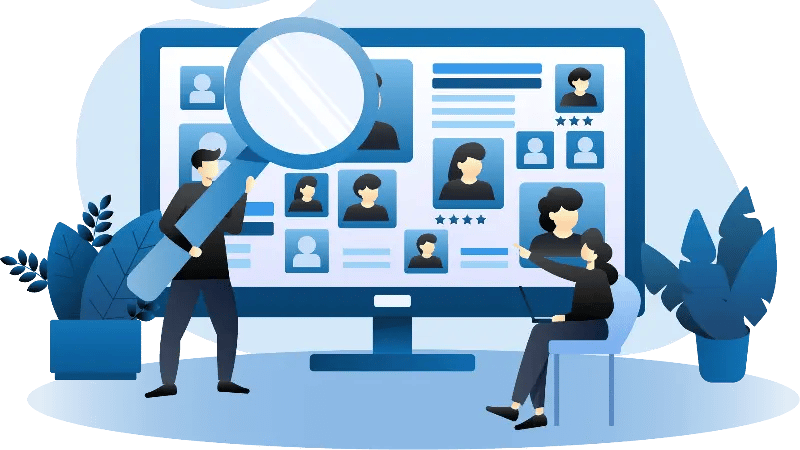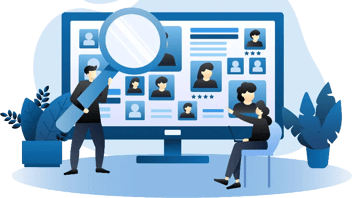What is an Ideal Customer Profile and Why Should My Business Have One?
Ever feel like your marketing efforts are hitting the wrong audience? You pour resources into attracting customers, only to find most aren't a good fit. Budgets bleed on campaigns that fall flat. Sound familiar? Enter the Ideal Customer Profile (ICP) – your secret weapon for attracting high-quality leads who convert.

What is an Ideal Customer Profile (ICP)?
In marketing and business development, shaping an Ideal Customer Profile (ICP) serves as the guiding force propelling businesses toward success. Departing from conventional demographics, this strategic framework now centers on essential factors such as company size, geography, growth trajectory, industry, and more.
Unlike a checklist of individual attributes like age, location, or gender or individuals, an ICP fosters a nuanced comprehension of companies' behaviors, preferences, and challenges. By transcending surface-level details, businesses can construct a comprehensive company-centric profile tailored to align with their offerings seamlessly.
Integrating buyer personas within this redefined ICP injects the human touch into data and connects your efforts to people. These fictional characters epitomize various target audience segments, vividly illustrating their aspirations, challenges, and decision-making processes. Personas breathe life into data, facilitating a deeper connection and strategic alignment within company-focused profiling.
Why is Having an ICP So Important?
In today's crowded marketplace, casting a wide net and hoping for the best simply doesn't cut it. Here's why having a well-defined ICP is crucial for your marketing success:
-
Increased Efficiency: No more wasting time and resources on the wrong audience. An ICP helps you focus your marketing efforts on those most likely to convert, maximizing your ROI and saving precious resources.
-
Enhanced Relevance: With a deep understanding of your ideal customer, you can craft messaging that resonates with their needs and pain points. This leads to more qualified leads, higher engagement, and better conversions.
-
Boosted Customer Satisfaction: When you attract the right companies, you set yourself up for long-term success. Your customers will be happier with your product or service because it truly solves their problems, leading to higher retention rates and positive word-of-mouth.
An ICP emerges as a strategic instrument for refining marketing endeavors and enhancing the company experience. It establishes a symbiotic relationship where the business customizes its offerings to meet company expectations, and reciprocally, companies become advocates for the brand.
Research shows that companies who nail the execution of their ICP are:
-
50% more likely to acquire new customers
-
Generate 30% more revenue from marketing
-
67% more likely to exceed quota.
-
277% more likely to close a deal.
As the business landscape becomes increasingly competitive, the ability to stand out and connect with your audience becomes paramount. An ICP is not just a document; it's a dynamic asset that evolves with your business and the ever-changing preferences of your customers.
What Should Your ICP Include?
These are the essential elements that should make up your ideal customer profile:
-
Company Specifics: Shift your focus from individual characteristics to company-centric details. Include factors such as company size, geography, growth trajectory ("we're hiring"), industry, and financial stability. These details provide a more nuanced understanding of your target corporate audience.
-
Operational Behaviors: Delve into the operational behaviors of your ideal corporate customer. Understand how they engage with your brand and others in your industry. Uncover their online habits, preferred media channels, and the triggers influencing their corporate buying decisions.
-
Demographic Insights: While traditional demographic details like age, gender, and location can be important when addressing individual prospects, adapt them to the corporate context. Explore aspects such as the company's employee structure, location of headquarters, and the industries they serve. These insights are a foundational starting point for understanding your corporate target audience.
-
Strategic Psychographics: Elevate your understanding beyond surface-level data by exploring the strategic psychographics of your ideal corporate customer. Dive into their corporate values, strategic interests, industry personality traits, and operational lifestyle. Uncover the motivations, challenges, and aspirations driving their corporate decisions, fostering a more profound connection.
Ideal Customer Profile vs. Buyer Persona
In customer-centric strategies, Ideal Customer Profiles (ICP) and Buyer Personas play distinct yet complementary roles. While often misconstrued as interchangeable, understanding their differences is crucial for crafting effective marketing initiatives.
Ideal Customer Profile
Think of your ICP as the high-level blueprint guiding your business towards its ideal customer base. This strategic framework zooms out, delineating broad characteristics such as industry, company size, budget, and tech stack. It's akin to identifying the target city on a map, outlining where your ideal clients reside.
-
Focus: Companies and organizations with specific attributes.
-
Level of Detail: High-level overview based on market research and data.
-
Purpose: Guides strategic choices like industry focus and product development.
Buyer Persona
In contrast, a buyer persona is a detailed portrait of an individual within your ICP. It delves deep into their motivations, challenges, decision-making process, and preferred communication channels. Imagine zooming in on your target city, identifying a specific street, and getting to know the resident who best embodies your ideal client.
-
Focus: Individual decision-makers within your target companies.
-
Level of Detail: Rich and nuanced, including personality traits, pain points, and media consumption habits.
-
Purpose: Informs messaging, content creation, and outreach strategies for different audience segments.
While distinct, ICP and buyer persona work together, driving marketing effectiveness. Your ICP sets the direction, like identifying the promising neighborhoods, while your buyer personas provide the street smarts, guiding you to connect with the specific residents within those areas.
-
ICP informs persona development: Knowing your target companies helps you define the individuals likely to influence buying decisions.
-
Personas refine marketing initiatives: Tailoring messaging and channels to specific personas ensures greater relevance and engagement.
-
Together, they form a powerful team: ICP guides strategy, while personas drive execution, maximizing the impact of your marketing efforts.
Here's an example of the role of buyer personas and ICPs working together:
Example: SaaS Company Targeting Marketing Agencies
Ideal Customer Profile (ICP):
- Industry: Marketing agencies specializing in digital marketing.
- Company Size: 10-50 employees with a dedicated marketing team.
- Location: North America, Europe, and Australia.
- Revenue: $1 million+ annual revenue.
- Tech Stack: Marketing automation platforms, CRM systems, and analytics tools.
- Challenges: Managing multiple client campaigns, increasing campaign efficiency, generating leads, reporting, and presenting results.
Buyer Persona (Marketing Manager):
- Name: Sarah, Marketing Manager at ABC Agency.
- Age: 35
- Education: Bachelor's Degree in Marketing.
- Personality: Data-driven, results-oriented, organized, and enjoys collaborating with team members.
- Pain Points: Feeling overwhelmed by managing multiple client campaigns, struggling to meet campaign performance goals, and difficulty demonstrating ROI to clients.
- Decision-Making Process: Researches potential solutions, gathers feedback from team members, and prioritizes features that increase efficiency and reporting capabilities.
- Media Consumption: Follows industry blogs, attends marketing conferences, and is active on LinkedIn and Twitter.
How ICP and Persona Inform Marketing:
- Content Creation: Develop blog posts, white papers, and case studies highlighting how your SaaS platform helps marketing agencies overcome common challenges Sarah faces.
- Messaging: Focus on ROI, efficiency, and team collaboration benefits, using data-driven language that resonates with Sarah's analytical personality.
- Outreach: Target advertising and social media campaigns towards marketing managers at agencies within the ICP criteria.
- Sales Approach: Tailor sales presentations to address Sarah's specific pain points and showcase how your solution can streamline her workflow and improve client reporting.
This example demonstrates how an ICP and buyer persona work together to inform targeted marketing strategies, ultimately increasing the likelihood of attracting and converting customers like Sarah within your ideal demographic.
How to Create an Ideal Customer Profile
Crafting an Ideal Customer Profile (ICP) is a strategic endeavor requiring a systematic approach.
1. Conduct market research
The foundation of an effective ICP lies in thorough market research. Dive into demographic data, analyze market trends, and explore competitors' strategies. Understand the pain points and aspirations of your target companies. This information serves as the building blocks for a nuanced ICP that resonates with your customers.
2. Analyze customer behavior
Beyond demographics, delve into the behavioral patterns of your ideal companies. Utilize tools and analytics to track online interactions, purchasing behaviors, and engagement metrics. Identify common touchpoints and preferences, allowing you to create a more accurate and actionable ICP.
3. Identify pain points and solutions
An effective ICP addresses the challenges your ideal companies face and provides tailored solutions. Conduct surveys, interviews, or feedback sessions to gain insights into their pain points. Your products or services should align seamlessly with these pain points, positioning your business as a problem solver and strengthening the connection with your audience.
While developing your ideal customer profile, keep an eye out for these common pitfalls:
-
Overreliance on Demographics: While demographics are crucial, relying solely on them may oversimplify your customer base. Go beyond basic characteristics to capture the complexity of your audience.
-
Static Profiles: Company needs, and behaviors evolve. Ensure your ICP remains dynamic, adapting to market and customer preference changes.
Creating an ICP is an iterative process. Regularly revisit and refine your profile based on evolving market dynamics and customer feedback. This adaptability ensures that your ICP remains relevant and effective over time.
Stop Casting in the Dark: The Secret Weapon for Attracting Ideal Clients
Forget casting a marketing net into the vast ocean and hoping for the best. With an ICP, you have a strategic targeting tool, ensuring that you catch what you want. Think of your ICP as a detailed blueprint for your perfect customer company. It's more than just demographics; it's a deep dive into their companies, budgets, tech stacks, and challenges. This precise targeting ensures your marketing efforts hit the bullseye, attracting the right companies every time.
The result? A marketing revolution. No more wasting resources on the wrong audience. Instead, you attract high-quality leads who convert effortlessly. Customer satisfaction soars as you consistently deliver solutions that address their specific needs. And your bottom line? Well, let's just say it experiences a significant upward trend.
Remember, your ICP and buyer persona are living documents. As you learn more about your target audience, refine and update them constantly. Ready to get started?
This content is also available in:
- Deutsch: Was ist ein ideales Kundenprofil und warum sollte ich eines haben?
- Español: ¿Qué es un perfil de cliente ideal y por qué mi empresa debería tener?
- Français: Pourquoi définir un profil client idéal pour votre entreprise ?
- Italiano: Profilo del Cliente Ideale: La chiave per il successo aziendale
- Română: Ce este un profil al clientului ideal? De ce e important?
- 简体中文: 什么是 理想客户档案,为什么我的企业需要 理想客户档案?









Leave a Comment